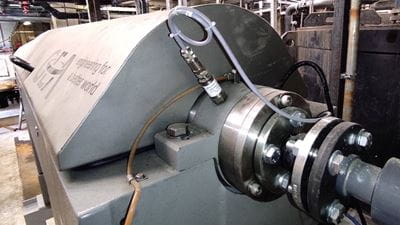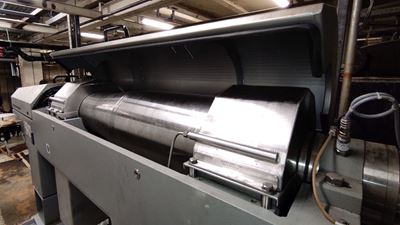Trade press release
GEA decanters are important components in the cleaning of soil contaminated with heavy metals
June 4, 2024
The Austrian company ferroDECONT has developed a process that converts highly toxic and soluble heavy metals into harmless, precipitated compounds in a washing process. The machine and plant manufacturer GEA supplied ferroDECONT with a decanter for the treatment of contaminated soils. The GEA decanter first separates the precipitated copper from water, after which the solid phase can then be recycled.

The machine and plant manufacturer GEA supplied ferroDECONT with the GCD 345 decanter for the treatment of contaminated soils. The GEA decanter primarily separates the precipitated copper from the water. The solid phase can then be recycled. (Photo: GEA)
Using the fluidized bed method for cleaning
This form of remediation is used successfully close to the Vienna-Schwechat Airport where ferroDECONT had provided its treatment technology. Dredged, contaminated soil is transported to this plant and washed with water. This is where ferroDECONT’s sophisticated cleaning process using the fluidized bed method begins. The contaminated soil is watered and pumped through plastic pipes. These tubes contain zero-valent iron granulate with a size of around four millimeters, i.e. the size of a peppercorn. The zero-valent iron acts as an electron donor and reduces higher-value pollutant compounds through oxidation. The aim is to reduce the toxicity of the compounds or to convert them into non-toxic compounds, i.e. to convert copper ions (Cu2+) into zero valence Cu(s) or Chromium(VI) into Chromium(III).
GEA corrosion resistant decanter securely separates copper from water
The final step in the process is to separate copper from the water. This is done using the GCD 345 decanter from GEA. The continuously operating centrifuge with a horizontal solid bowl was specially selected to meet the requirements for maximum efficiency. The rotating parts of the decanter are made of duplex stainless steel. Duplex has high corrosion resistance and strength. Separation with the GEA decanter results in a copper solids phase in addition to the water, which can be recycled in the sense of closing the cycle. The decanter centrifuge was chosen for this separation task was selected because of its reliable and continuous operation. An efficient separation of water from the solids, a closed system with high security for operation and environment as well as its small footprint are achieved.

This is what the GEA decanter GCD 345 looks like from the inside. (Photo: GEA)
Background information:
ferroDECONT
ferroDECONT GmbH from Leoben, Austria, offers solutions for the remediation of contaminated sites and the treatment of industrial and process water contaminated with heavy metals. The modular process concept is suitable both for implementation in existing processes and as a stand-alone variant in the form of a flexible, mobile container system.
ferroDECONT’s innovative Pump & Treat remediation technology, in which wastewater containing heavy metals is pumped through fluidized bed reactors and thus rendered harmless, can save disposal costs or treat water for recycling. As a spin-off company of the University of Leoben, ferroDECONT has excellent connections to the university's research and development department, which fosters further innovations in its work that directly benefit customers.
The GEA decanter GCD 345
The advantages of the GEA decanter GCD 345 are
- High separation performance:
- High g-force for better solids recovery
- Long dwell time in the centrifugal zone
- Low maintenance costs:
- Drum made of durable duplex stainless steel
- Hinged hood for quick and easy inspection
- Adjustable drum speed to reduce wear caused by abrasive particles
- Very resistant and durable armoring of the scroll flights
- Smooth and continuous operation
- Machine with CIP capability
- Small footprint
Illustrative example for chromium(VI)
Chromium(VI) oxide, also known as chromium trioxide (CrO3) is an oxide of chromium. It is a dark red solid that is hygroscopic and easily soluble in water. The aqueous solution of the chromate anion CrO42- reacts strongly acidic. Chromium(VI) oxide is oxidizing and increases the risk of fire or explosion when in contact with flammable substances. Chromium(VI) oxide is very toxic, even 0.6 g taken orally can be fatal. If swallowed, digestive disorders, kidney damage, cramps and paralysis are the result. Chromium(VI) is also carcinogenic, mutagenic and toxic to reproduction. Aqueous solutions of chromium(VI) oxide are highly corrosive. The solid also causes severe burns on contact with skin and mucous membranes. Chromium(VI) oxide is hazardous to the environment and highly hazardous to water (water hazard class 3).
Chromium(III)
The term chromium(III) stands for trivalent chromium. Colloquially, it is often just called chromium oxide. In pigment form, it is also called chromium oxide green. Chromium(III) is increasingly being used for chrome plating instead of chromium(VI) because, unlike hexavalent chromium, it is non-toxic. Chromium(III) oxide is a green, hard and relatively heavy powder that is used as a chromium dioxide green pigment. Green crystals are also available commercially for laboratory use. Chromium(III) oxide is completely insoluble in water and does not react with acids. It remains stable even when heated to high temperatures, with a melting point of 2,320 °C. Chromium(III) oxide is non-toxic and is not classified as a hazardous substance.
Dr. Michael Golek
About GEA
GEA es uno de los mayores proveedores para la industria alimentaria y para muchos otros sectores de la industria. En 2019 generó unos ingresos consolidados de 4.900 millones de euros aproximadamente.
